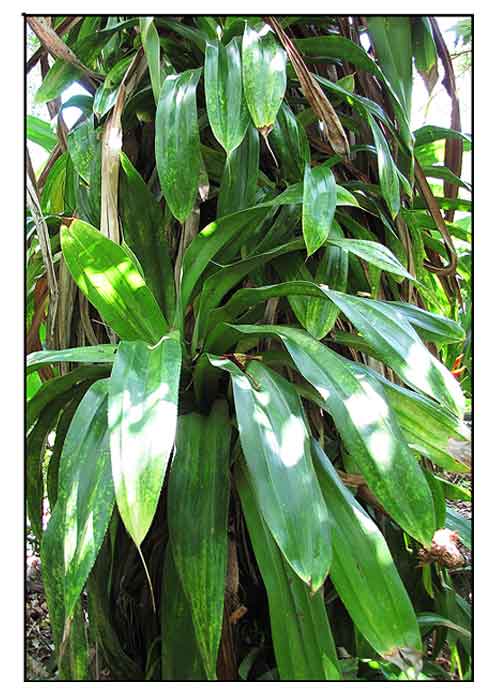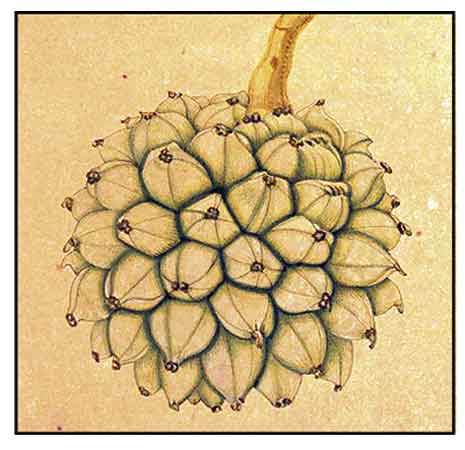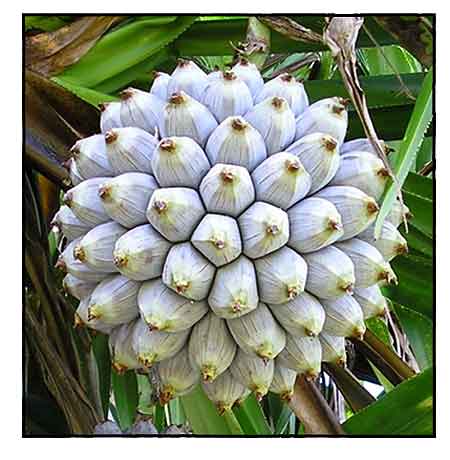
Family • Pandanaceae
Taboan
Bakong
Pandanus dubius Spreng.
KNOB-FRUITED SCREWPINE
| Scientific names | Common names |
| Barrotia gaudichaudii Brongn. | Bakong (Tag.) |
| Barrotia tetrodon Gaudich. | Bangcoang (Tag.) |
| Hombronia edulis Gaudich. | Bonsok (Tag.) |
| Pandanus bagea Miq. | Taboan (Bis.) |
| Pandanus bidoer Jungh. | Taoban (Tag.) |
| Pandanus bidur Jungh. ex Miq. | Knob-fruited screwpine (Engl.) |
| Pandanus compressus Martelli | |
| Pandanus dubius Spreng. | |
| Pandanus dubius var. compressus (Martelli) B.C.Stone | |
| Pandanus edulis (Gaudich.) de Vriese | |
| Pandanus hombronia F.Muell. | |
| Pandanus kafu var. confluentus Kaneh. | |
| Pandanus latifolius Perr. | |
| Pandanus latissimus Blume ex Miq. | |
| Pandanus odoratus Thunb. | |
| Pandanus pacificus J.H.Veitch | |
| Pandanus tetrodon (Gaudich.) Balf.f. | |
| Pandanus yamagutii Kaneh. | |
| Bakong is a local name shared by (1) Crinum asiaticum (2) Crinum latifolium, lirio (3) Hymenocallis littorale, spider lily, and (4) Pandanus dubius. | |
| Pandanus dubius is an accepted species. KEW: Plants of the World Online | |
| Other vernacular names |
| CUBA: Pandano. |
| FIJI: Hosoa. |
| GUAM: Pabon, Pabong, Pahon, Pahong. |
| INDIA: Vilayati keora. |
| INDONESIA: Pung, Boku, Haun pantai, Pandan pantai buah durian. |
| JAPANESE: Dyubiusu. |
| MICRONESIA: Padanus, Pakoa. |
| NORTHERN MARIANA IS: Pafung. |
| PALAU: Poko. |
| SOLOMON ISLANDS: Fau, Kakaru, Iowo, Meongele, Meou, Nianöde, Paki. |
| THAILAND: Toei kaeo. |
| VANUATU: Vakoa. |
Botany
Constituents Properties Studies Availability |
March 2023
![]()
 |
| Â Â Â Â Â Â Â Â Â Â Â Â Â Â Â Â Â Â Â Â Â Â Â Â Â PHOTOS / ILLUSTRATIONS |
| IMAGE SOURCE: Photograph: Pandanus dubius leaves / Forest & Kim Starr / CC BY 3.9 us / click on image to go to source page / Wikipedia |
| OTHER IMAGE SOURCE: Ilustration: Pandanus dubius Spreng / Naturalis Biodiversity Center / CCO / click on image to go to source page / Wikipedia |
| OTHER IMAGE SOURCE: Photograph: Pandanus dubius / © Summer Hibiscus / Non-commercial use / click on image to go to source page / Summer Hibiscus |
Additional
Sources and Suggested Readings |
• |
DOI: It is not uncommon for links on studies/sources to change. Copying and pasting the information on the search window or using the DOI (if available) will often redirect to the new link page. (Citing and Using a (DOI) Digital Object Identifier) |
| Â Â Â Â Â Â Â Â Â Â Â Â Â Â Â Â Â Â Â Â Â Â Â Â Â Â Â Â Â Â List of Understudied Philippine Medicinal Plants |
• |
 |




